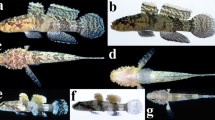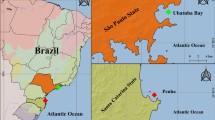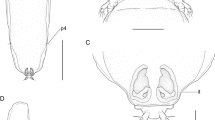Abstract
Longidorus behshahrensis n. sp. is described and illustrated using morphological and molecular data. It was recovered from the rhizosphere of a wild cherry tree in Mazandaran province, northeastern Iran. The new species is characterized by having 6.8–8.4 mm long females, lip region separated from the rest of the body by a shallow depression, amphidial fovea pocket shaped not bilobed, guiding ring at 25–31 μm from the anterior end, 81–91 and 51–63 μm long odontostyle and odontophore, respectively, 109–130 μm long pharyngeal bulb, didelphic-amphidelphic reproductive system with long tubular bipartite uteri with sperm, vulva at 44–54%, tail bluntly conical, dorsally convex, ventrally concave with widely rounded terminus, hyaline region with discernible radial lines; males common with 50–60 μm long spicules and 9–11 ventromedian single supplements. Only the two latter juvenile developmental stages were recovered for the new species. Codes for identifying the new species are A3-B1-C23-D2-E1-F34-G23-H2-I2. Morphologically, the new species comes close to eight known species of the genus namely L. artemisiae, L. dunensis, L. elongatus, L. euonymus, L. goodeyi, L. iranicus, L. protae and L. tabrizicus. The morphological differences of the new species and the aforementioned species are discussed. In molecular phylogenetic analyses using LSU rDNA D2-D3 sequences, the position of the new species among closely related species was not resolved due to polytomy. In ITS1 phylogeny, the new species formed a clade with L. distinctus.




Similar content being viewed by others
Notes
The specific epithet refers to the geographical distribution point of the new species.
References
Álvarez-Ortega, S., & Pena-Sañtiago, R. (2012). Nematodes of the order Dorylaimida from Andalucía Oriental, Spain. Nevadanema nevadense gen. n., sp. n. (Qudsianematidae) from Sierra Nevada National Park. Nematology, 14, 249–264. https://doi.org/10.1163/138855411X589309.
Archidona-Yuste, A., Navas-Cortés, J. A., Cantalapiedra-Navarrete, C., Palomares-Rius, J. E., & Castillo, P. (2016). Unravelling the biodiversity and molecular phylogeny of needle nematodes of the genus Longidorus (Nematoda: Longidoridae) in olive and a description of six new species. PLoS One. https://doi.org/10.1371/journal.pone.0147689.
Archidona-Yuste, A., Cantalapiedra-Navarrete, C. C., Castillo, P., & Palomares-Rius, J. E. (2019). Molecular phylogenetic analysis and comparative morphology reveals the diversity and distribution of needle nematodes of the genus Longidorus (Dorylaimida: Longidoridae) from Spain. Contributions to Zoology, 88, 1–41 https://doi.org/10.1163/18759866-20191345.
Barsalote, E. M., Pham, H. T., Lazarova, S., Peneva, V., & Zheng, J. (2018). Description of Longidorus cheni sp. n. (Nematoda, Longidoridae) from China. Zookeys, 744, 1–18. https://doi.org/10.3897/zookeys.744.23265.
Bayat, M., Namiranian, M., & Zobeiri, M. (2013). Productivity and optimal management of the uneven-aged hardwood forests of Hyrcania. European Journal of Forest Research, 132, 851–864. https://doi.org/10.1007/s10342-013-0714-1.
Brinkman, H., Loof, P. A. A., & Barbez, D. (1987). Longidorus dunensis n. sp. and L. kuiperi n. sp. from the sand dune coastal region of the Netherlands (Nematoda: Longidoridae). Revue de Nématologie, 10, 299–308.
Chen, Q., Hooper, D. J., Loof, P. A. A., & Xu, J. (1997). A revised polytomous key for the identification of species of the genus Longidorus Micoletzky, 1922 (Nematoda: Dorylaimoidea). Fundamental & Applied Nematology, 20, 15–28.
Cohn, E. (1970). Observations on the feeding and symptomatology of Xiphinema and Longidorus on selected host roots. Journal of Nematology, 2, 167–173.
De Grisse, A. T. (1969). Redescription ou modifications de quelques techniques utilisées dans l’étude des nematodes phytoparasitaires. Mededelingen Rijksfakulteit Landbouwwetenschappen, Gent, 34, 351–369.
De Man, J. G. (1876). Onderzoekingen over vrij in de aarde levende nematoden. Tijdschrift der Nederlandsche Dierkundige Vereeniging, 279–196.
Decraemer, W., & Chaves, E. (2012). Longidoridae and Trichodoridae. In R. H. Manzanilla-Lopez & N. Marbán-Mendoza (Eds.), Practical plant nematology (pp. 579–617). Bibliotheca Basica de Agricultura: Montecillo.
Gharibzadeh, F., Pourjam, E., & Pedram, M. (2018). Description of Longidorus azarbaijanensis n. sp. (Dorylaimida: Longidoridae) from Iran. Journal of Nematology, 50, 207–218. https://doi.org/10.21307/jofnem-2018-009.
Giti, M., Kashi, L., & Pedram, M. (2019). Data of an Iranian population of L. proximus Sturhan & Argo, 1983, with taxonomic revision of L. israelensis Peneva, Orion, Shlevin, bar-Eyal & Brown, 1998 (Nematoda: Longidoridae) and proposal for a new synonymy. Journal of Nematology, 51, e2019–e2054. https://doi.org/10.21307/jofnem-2019-054.
Hooper, D. J. (1961). A redescription of Longidorus elongatus (de Man, 1876) Thome & Swanger, 1936 (Nematoda, Dorylaimidae) and descriptions of five new species of Longidona from Great Britain. Nematologica, 6, 237–257. https://doi.org/10.1163/187529261X00072.
Hunt, D. J. (1993). Aphelenchida, longidoridae and trichodoridae, their systematics and bionomics. Wallingford: CAB International.
Huson, D. H., & Scornavacca, C. (2012). Dendroscope 3: an interactive tool for rooted phylogenetic trees and networks. Systematic Biology, 61, 1061–1067. https://doi.org/10.1093/sysbio/sys062.
Katoh, K., & Standley, D. M. (2013). MAFFT multiple sequence alignment software version 7: improvements in performance and usability. Molecular Biology and Evolution, 30, 772–780. https://doi.org/10.1093/molbev/mst010.
Kiontke, K., Gavin, N. P., Raynes, Y., Roehrig, C., Piano, F., & Fitch, D. H. (2004). Caenorhabditis phylogeny predicts convergence of hermaphroditism and extensive intron loss. Proceedings of the National Academy of Sciences of the United States of America, 101, 9003–9008.
Lamberti, F., & Bleve-Zacheo, T. (1977). Two new species of Longidorus (Nematoda: Longidoridae) from Italy. Nematologia Mediterranea, 5, 73–83.
Lamberti, F., Choleva, B., & Agostinelli, A. (1983). Longidoridae from Bulgaria (Nematoda, Dorylaimida) with description of three new species of Longidorus and two new species of Xiphinema. Nematologia Mediterranea, 11, 49–72.
Lazarova, S. S., Elshishka, M., Radoslavov, G., Lozanova, L., Hristov, P., Mladenov, A., Zheng, J., Fanelli, E., De Luca, F., & Peneva, V. K. (2019). Molecular and morphological characterization of Longidorus polyae sp. n. and L. pisi Edward, Misra & Singh, 1964 (Dorylaimida, Longidoridae) from Bulgaria. Zookeys, 830, 75–98. https://doi.org/10.3897/zookeys.830.32188.
Larget, B., & Simon, D. L. (1999). Markov chain Monte Carlo algorithms for the Bayesian analysis of phylogenetic trees. Molecular Biology and Evolution, 16, 750–759. https://doi.org/10.1093/oxfordjournals.molbev.a026160.
Loof, P. A. A., & Coomans, A. (1972). The oesophageal gland nuclei of Longidoridae (Dorylaimida). Nematologica, 18, 213–233. https://doi.org/10.1163/187529272X00458.
Loof, P. A., & Chen, Q. W. (1999). A revised polytomous key for the identification of species of the genus Longidorus Micoletzky, 1922 (Nematoda: Dorylaimoidea). Supplement 1. Nematology, 1, 55–59. https://doi.org/10.1163/156854199507974.
Luc, M., Lima, M. B., Weischer, B., & Flegg, J. J. M. (1964). Xiphinema vuittenezi n. sp. (Nematoda: Dorylaimidae). Nematologica, 10, 151–163. https://doi.org/10.1163/187529264X00781.
Mali, V. R., & Hooper, D. J. (1973). Observations on Longidorus euonymus n. sp. & Xiphinema vuittenezi Luc et al., 1964 (Nematoda: Dorylaimida) associated with spindle trees infected with euonymus mosaic virus in Czechoslovakia. Nematologica, 19, 459–467. https://doi.org/10.1163/187529273X00457.
Micoletzky, H. (1922). Die freilebenden Erd-Nematoden. Arch. Naturgesch. Berlin (1921) 87. Abt, A 8/9, 1–650.
Niknam, G., Pedram, M., Nejad, E. G., Ye, W., Robbins, R. T., & Maafi, Z. T. (2010). Morphological and molecular characterization of Longidorus tabrizicus sp. n. and L. sturhani Rubtsova, Subbotin, Brown & Moens, 2001 (Nematoda: Longidoridae) from North-Western Iran. Russian Journal of Nematology, 18, 127–140.
Nunn, G. B. (1992). Nematode molecular evolution and investigation of evolutionary patterns among nematodes based on DNA sequences. Nottingham: University of Nottingham.
Nylander, J. A. A. (2004). MrModeltest v2. Program distributed by the author. Evolutionary Biology Centre, Uppsala University.
Pedram, M. (2018). Nematodes of the family Longidoridae. In: Ghaderi, R., Kashi, L. & Karegar, A. (Eds). Plant-parasitic nematodes in Iran. Science Reference in collaboration with the Iranian Society of Nematology, 627–667. (in Persian).
Robbins, R. T., Brown, D. J. F., Halbrendt, J. M., & Vrain, T. C. (1995). Compendium of Longidorus juvenile stages with observations on L. pisi, L. taniwha, and L. diadecturus (Nematoda: Longidoridae). Systematic Parasitology, 32, 33–52. https://doi.org/10.1007/BF00009466.
Roca, F., Pereira, M. J., & Lamberti, F. (1989). Longidorus alvegus sp. n. (Nematoda, Dorylaimida) from Portugal. Nematologia Mediterranea, 17, 1–4.
Ronquist, F., & Huelsenbeck, J. P. (2003). MrBayes 3: Bayesian phylogenetic inference under mixed models. Bioinformatics, 19, 1572–1574. https://doi.org/10.1093/bioinformatics/btg180.
Rubtsova, T. V., Chizhov, V. N., & Subbotin, S. A. (1999). Longidorus artemisiae sp. n. (Nematoda: Longidoridae) from roots of Artemisia sp., Rostov region, Russia. Russian Journal of Nematology, 1999, 7(1), 33–38.
Silvestro, D., & Michalak, I. (2011). raxmlGUI: a graphical frontend for RAxML. Organisms Diversity & Evolution, 12, 335–337. https://doi.org/10.1007/s13127-011-0056-0.
Sturhan, D., & Barooti, S. H. (1983). Longidorus iranicus n. sp. (Nematoda: Dorylaimida). Systematic Parasitology, 5, 21–24. https://doi.org/10.1007/BF00010982.
Subbotin, S., Halford, P. D., Warry, A., & Perry, R. N. (2000). Variations in ribosomal DNA sequences and phylogeny of Globodera parasitising solanaceous plants. Nematology, 2, 591–604. https://doi.org/10.1163/156854100509484.
Tamura, K., Peterson, D., Peterson, N., Stecher, G., Nei, M., & Kumar, S. (2011). MEGA5: molecular evolutionary genetics analysis using maximum likelihood, evolutionary distance, and maximum parsimony methods. Molecular Biology and Evolution, 28, 2731–2739. https://doi.org/10.1093/molbev/mst197.
Thorne, G., & Allen, M. W. (1950). Paratylenchus hamatus n. sp. and Xiphinema index n. sp., two nematodes associated with fig roots, with a note on Paratylenchus anceps cobb. Proceedings of the Helminthological Society of Washington, 17, 27–35.
Wyss, U. (2010). Feeding behavior of plant-parasitic nematodes. In D. L. Lee (Ed.), The biology of nematodes (pp. 462–513). Boca Ratón: Taylor & Francis Group.
Xu, Y., Ye, W., Wang, J., & Zhao, Z. (2018). Morphological and molecular characterisation of Longidorus pinus sp. n. (Nematoda: Longidoridae) from China and a key to known species of Longidorus in China. Nematology, 20, 617–639. https://doi.org/10.1163/15685411-00003165.
Acknowledgements
We acknowledge the Science and Research Branch of Islamic Azad University (Iran) and Tarbiat Modares University (Iran) for their financial support. The study was partly supported by BAS, ANIDIV3 project.
Author information
Authors and Affiliations
Corresponding author
Ethics declarations
Conflict of interest
All the authors certify that they do not have any conflict of interest, the presented data are original and the described species is not published, and is not under evaluation for publication elsewhere, all prevailing local, national and international regulations and conventions, and normal scientific ethical practices, have been respected. They also certify that the final version of this manuscript has been reviewed by all authors.
Research involving human participants and/or animals
No specific permits were required for this study. The soil samples analyzed in this study were obtained in public areas, forests, and grasslands, that are not under protection.
Informed consent
The authors certify that they have accepted the principles of ethical standards and that guidelines of professional conduct have been followed. The funders had no role in designing of this study, collecting and analyzing of the data, preparing the manuscript and are not involved in evaluating or publishing process of this research.
Electronic supplementary material
ESM 1
The LSU Bayesian tree inferred using maximal number of available data. This tree is used to infer a pruned smaller LSU tree. (JPG 550 kb)
Rights and permissions
About this article
Cite this article
Bakhshi Amrei, S., Peneva, V., Rakhshandehroo, F. et al. Morphological and molecular description of Longidorus behshahrensis n. sp. (Nematoda: Longidoridae) from natural forests of Abbas Abad, north of Iran. Eur J Plant Pathol 156, 387–398 (2020). https://doi.org/10.1007/s10658-019-01884-y
Accepted:
Published:
Issue Date:
DOI: https://doi.org/10.1007/s10658-019-01884-y




